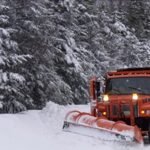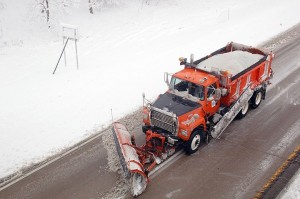
Minnesota Crews Target Changes to Reduce Chlorides in Runoff
 Road deicing is a major cause of chloride impairment in Minnesota’s urban waters. Aiming to reduce these impacts, Minnesota DOT researchers partnered with the City of Edina to test an adaptive management approach to deicing.
Through adaptive management—repeatedly checking the effects of actions and making adjustments—the researchers found that most of the chloride movement in a residential watershed occurred during a small number of winter events, which allowed maintenance staff to make targeted adjustments to their deicing operations. Researchers created a training manual on using adaptive management for deicing and a spreadsheet tool to help agencies improve their deicing operations.
Visit the project page and read the final report: Adaptive Management to Improve Deicing Operations, Minnesota DOT, March 2021.
Image courtesy of Minnesota DOT
Road deicing is a major cause of chloride impairment in Minnesota’s urban waters. Aiming to reduce these impacts, Minnesota DOT researchers partnered with the City of Edina to test an adaptive management approach to deicing.
Through adaptive management—repeatedly checking the effects of actions and making adjustments—the researchers found that most of the chloride movement in a residential watershed occurred during a small number of winter events, which allowed maintenance staff to make targeted adjustments to their deicing operations. Researchers created a training manual on using adaptive management for deicing and a spreadsheet tool to help agencies improve their deicing operations.
Visit the project page and read the final report: Adaptive Management to Improve Deicing Operations, Minnesota DOT, March 2021.
Image courtesy of Minnesota DOT
LED Plow Lights Show Benefits in New Hampshire
LED plow headlights have several potential advantages over traditional halogen bulbs, including longer life, reduced susceptibility to damaging vibrations, and improved visibility and reduced eye fatigue for operators. To compare the two bulb types, New Hampshire DOT tested LED lights on 17 plow trucks and surveyed operators about their experiences. Operators overwhelmingly preferred the LED … Read more

New Clear Roads Research: Advanced Technologies for Winter Operations
 Advanced technologies like mobile sensor systems, video analytics and enhanced maintenance decision support systems (MDSS) have the potential to help transportation agencies advance the state of winter maintenance operations.
A recent Clear Roads research project developed a guide to implementing eight emerging and recently developed winter maintenance technologies. By understanding the options and their benefits, agencies can make informed decisions about which technologies to invest in.
Download the final report: Integrating Advanced Technologies into Winter Operations Decisions, December 2020.
Image source: Nebraska DOT
Advanced technologies like mobile sensor systems, video analytics and enhanced maintenance decision support systems (MDSS) have the potential to help transportation agencies advance the state of winter maintenance operations.
A recent Clear Roads research project developed a guide to implementing eight emerging and recently developed winter maintenance technologies. By understanding the options and their benefits, agencies can make informed decisions about which technologies to invest in.
Download the final report: Integrating Advanced Technologies into Winter Operations Decisions, December 2020.
Image source: Nebraska DOT
New Podcast Episodes from SICOP Talks Winter Ops
 Check out these two new episodes from AASHTO’s SICOP Talks Winter Ops podcast:
Check out these two new episodes from AASHTO’s SICOP Talks Winter Ops podcast:
- Public Affairs, a Key Ingredient for Successful Winter Operations (Episode 47): A conversation with Anne Meyer of Minnesota DOT about the role public affairs professionals play in getting the winter operations message out to the driving public. May 2021. Podcast.
- Ways to Improve Winter Resilience of Roads (Episode 46): Mark Corbin of the UK’s Transport for West Midlands discusses what he learned during extensive research on winter resilience in several countries. April 2021. Podcast.

Clear Roads Selects 2021 Research Projects
 The Clear Roads Technical Advisory Committee met April 13-15 to select research projects for 2021 funding. The TAC selected seven new projects:
The Clear Roads Technical Advisory Committee met April 13-15 to select research projects for 2021 funding. The TAC selected seven new projects:
- Grip Sensor Technology and Salt Applications
- Best Practices for Protecting DOT Equipment from the Corrosive Effects of Chemical Deicers (Update to CR 13-04)
- Efficacy and Environmental Impact of Non-Chloride Deicers
- Training Module Development for CR 18-03: Evaluation of SSI and WSI Variables
- Evaluation of Electric Vehicle Technologies for Winter Operations
- Calculating Plow Cycle Times from AVL Data
- Determining the Migration of Chloride-Based Deicers Through Different Soil Types Adjacent to Chloride-Treated Roadways

New Clear Roads Research: Tools and Strategies for Developing Severity Indexes

Many agencies use storm severity indexes and winter severity indexes to make comparisons between storms and across multiple winter seasons. But developing an effective severity index can be challenging due to the multitude of variables involved and the availability and quality of data.
To help agencies find the right fit, a recent Clear Roads research project created a step-by-step guide to implementing a severity index and a flowchart tool that helps match users with existing indexes. Both tools help states assess the most feasible option: using or modifying an existing severity index or developing a new custom index. Download the final report and appendices: Evaluation of SSI and WSI Variables, December 2020. Image source: Utah DOT.
Illinois Examines Snow Fence Design, Cost-Effectiveness
 By preventing blowing snow from reaching the roadway, snow fences have proven to be an important tool for many state DOTs. In Illinois, two recent studies are helping IDOT refine its approach to snow fence design and better assess the fences’ cost-effectiveness.
A new benefit-cost analysis tool will help IDOT select locations for three fence types: living snow fences, structural snow fences and standing corn rows. For living snow fences, the research provides guidance on fence setback, orientation, height and porosity, as well as recommended plant species.
Read the research reports:
By preventing blowing snow from reaching the roadway, snow fences have proven to be an important tool for many state DOTs. In Illinois, two recent studies are helping IDOT refine its approach to snow fence design and better assess the fences’ cost-effectiveness.
A new benefit-cost analysis tool will help IDOT select locations for three fence types: living snow fences, structural snow fences and standing corn rows. For living snow fences, the research provides guidance on fence setback, orientation, height and porosity, as well as recommended plant species.
Read the research reports:
- Evaluating the Costs and Benefits of Snow Fences in Illinois: Phase 2, Illinois DOT, November 2020.
- Design of Living Barriers to Reduce the Impacts of Snowdrifts on Illinois Freeways, Illinois DOT, November 2020.

New Clear Roads Research: Standard Specifications for Carbide Plow Blades
 A recent Clear Roads research project developed standard procurement specifications for carbide-insert plow blades that any agency can download and use. Designed to help agencies acquire high-quality, long-lasting blades that consistently perform well on the road, the specifications also provide thorough guidance for independent lab testing and inspection of carbide inserts.
Download the specifications and final report: Standard Specifications for Plow Blades with Carbide Inserts, April 2020.
Image source: Massachusetts DOT
A recent Clear Roads research project developed standard procurement specifications for carbide-insert plow blades that any agency can download and use. Designed to help agencies acquire high-quality, long-lasting blades that consistently perform well on the road, the specifications also provide thorough guidance for independent lab testing and inspection of carbide inserts.
Download the specifications and final report: Standard Specifications for Plow Blades with Carbide Inserts, April 2020.
Image source: Massachusetts DOT
Iowa Adds to Popular Winter Operations Training Videos
 A step-by-step guide to spreader calibration is the latest addition to Iowa DOT’s popular Winter Operations Training video series. The 10-minute calibration video includes demonstrations on both granular and liquid equipment.
Updated in 2020, Iowa DOT’s training videos have long been a valuable resource for winter maintenance programs in Iowa and beyond. The series includes 14 short videos on topics such as plowing techniques, equipment checks and using weather resources.
Watch the videos: Iowa DOT Winter Operations Training Series, updated October 2020.
For more on this topic, see Clear Roads’ Training Resources and Spreaders Research pages.
Image source: Iowa DOT
A step-by-step guide to spreader calibration is the latest addition to Iowa DOT’s popular Winter Operations Training video series. The 10-minute calibration video includes demonstrations on both granular and liquid equipment.
Updated in 2020, Iowa DOT’s training videos have long been a valuable resource for winter maintenance programs in Iowa and beyond. The series includes 14 short videos on topics such as plowing techniques, equipment checks and using weather resources.
Watch the videos: Iowa DOT Winter Operations Training Series, updated October 2020.
For more on this topic, see Clear Roads’ Training Resources and Spreaders Research pages.
Image source: Iowa DOT
Minnesota DOT Tests Snowplow-Activated Warning Signs
 Drivers on a stretch of Interstate 35 in southern Minnesota received advance warning this winter when snowplows were working nearby. In an effort to reduce crashes, Minnesota DOT pilot-tested technology that uses highway message signs to let motorists know when slow-moving plows are ahead on the highway.
Ten snowplows were outfitted with the technology, which activates the message signs as the plows pass. The signs display a warning message, such as “Snowplow ahead: Use caution,” that stays activated for several minutes. The pilot project is part of MnDOT’s connected and automated vehicle research.
Read the press release: “MnDOT tests I-35 snowplow activation of warning signs to boost safety,” January 2021.
Photo by David Gonzalez, Minnesota DOT
Drivers on a stretch of Interstate 35 in southern Minnesota received advance warning this winter when snowplows were working nearby. In an effort to reduce crashes, Minnesota DOT pilot-tested technology that uses highway message signs to let motorists know when slow-moving plows are ahead on the highway.
Ten snowplows were outfitted with the technology, which activates the message signs as the plows pass. The signs display a warning message, such as “Snowplow ahead: Use caution,” that stays activated for several minutes. The pilot project is part of MnDOT’s connected and automated vehicle research.
Read the press release: “MnDOT tests I-35 snowplow activation of warning signs to boost safety,” January 2021.
Photo by David Gonzalez, Minnesota DOT